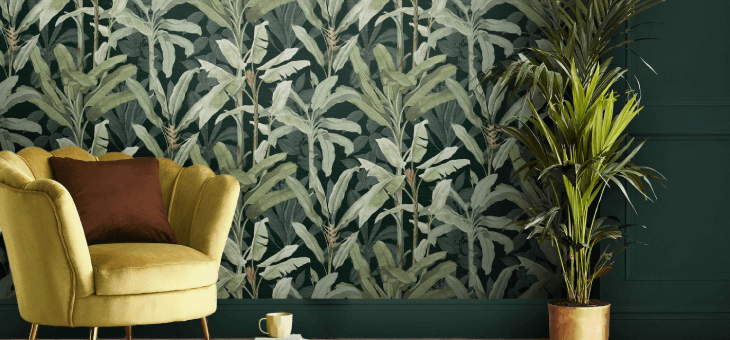Wallpaper is a wonderful thing. Thanks to a whole host of new trends – from the Bridgerton bug to retro revivals – we’re rolling out wallpaper like never before.
It’s also come a long way from the boring sheets that were a hassle to put up. Prints are now much more modern and ‘paste the wall’ styles mean there’s no need for a tiresome pasting table – so it’s easier than ever to transform a room.
Here’s what’s trending in the world of wallpaper.
Botanicals

“Biophilic design has been growing over the past year, and it’s certainly here to stay,” says James Greenwood, wallpaper expert for Graham & Brown (grahambrown.com).

“This trend revolves around nature, and all the beauty it can add to our homes. From bold florals to the calming green trees, this trend puts life into living spaces.”
Read: Seven interior design trends taking off

Whether it’s floral and fanciful or lush and leafy, there is a world of possibilities within the botanical trend.
Retro

Trends are showing that people are having a renewed appreciation for design elements inspired by the 1960s and ’70s.

“We’ve seen a huge resurgence of vintage-inspired wallpapers, and this trend is only growing as the new season of Netflix’s Stranger Things, set in the 1980s, hits our screens,” says Mr Greenwood.

To achieve the ’80s look, he suggests going for bold colours and fun geometric patterns.
Bridgerton

Bridgerton is another show inspiring everything from our clothes to our interiors – and Regencycore styles have made their way into wallpaper. Think cool blues, and walls awash with elegance. Use wallpaper to turn the living room into a beguiling Bridgerton masterpiece with a pattern that tells a story.
Read: Five easy updates for a home makeover
Ready to rock the trends? These are Mr Greenwood’s tips for hanging wallpaper.
1. Preparation
“To ensure a professional finish, you must prep your walls, so they’re smooth and clean for your wallpaper,” he advises. “To achieve this, use some filler to fill in any holes in the wall, then sand to smooth down. Once any filler is dry, clean the wall with sugar soap.”
2. Starting out

“The first drop of wallpaper is the most important, as everything will align to this point. To ensure you get it right, make sure the wall is plumb [perfectly vertical] – using either a plumb bob or spirit level to create a plumb line.
“Start 50 centimetres in from the first corner, or if you have a focal point on your wall – such as a fireplace – start here to ensure the design is centered.”
3. Paste the wall
“Paste the wall so you can apply the paper to your walls with ease,” Mr Greenwood says.
“Simply paste the area for your first drop, ensuring you cover every inch in paste. We recommend using a roller for large areas, and a brush to get around the trickier areas. Make sure to spread your paste a few centimetres extra for each drop, to ensure the edges have something to adhere to.”
4. Hanging
“Apply your wallpaper from the top of the wall, leaving a couple of centimetres spare to ensure there is no gap between the wall and ceiling. Slowly ease the wallpaper down the wall, brushing lightly as you go along, to make sure the paper lies smoothly,” Mr Greenwood advises.
“When you reach the bottom, simply trim the excess paper and move to the right to start your next drop. Make sure to check where your design matches up to the first drop and align accordingly, then follow the original steps until you complete the wall.”
5. Corners and tricky areas
He continues: “Some areas of the wall can be more challenging, such as corners and plug sockets. For internal corners, paste the wallpaper onto the wall as normal, and brush the wallpaper around the corner by a few centimetres.
“Then move onto the other side of the corner, repeating this process. This will cause the two papers to overlap, which can be left to dry and then trimmed with a sharp blade to remove excess paper. A similar process can be followed for external corners, wrapping the paper around the corner, and trimming any overlap.
Read: Nine disastrous DIY mistakes everyone makes

“For plug sockets, switch off your power at the mains and unscrew the socket to loosen it from the wall. Then you can simply paste the wallpaper as usual, and let the paper drop over the socket. Then mark the corners and cut the paper with an X shape. The paper can then be slid around the socket for a flush finish.”
Do you have wallpaper at home? What do you think of these statement styles? Share your thoughts in the comments section below.
– With PA
If you enjoy our content, don’t keep it to yourself. Share our free eNews with your friends and encourage them to sign up.

